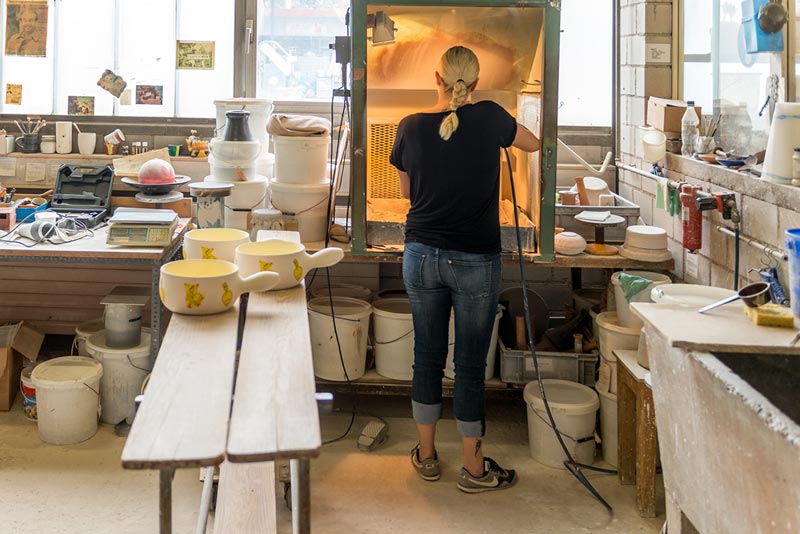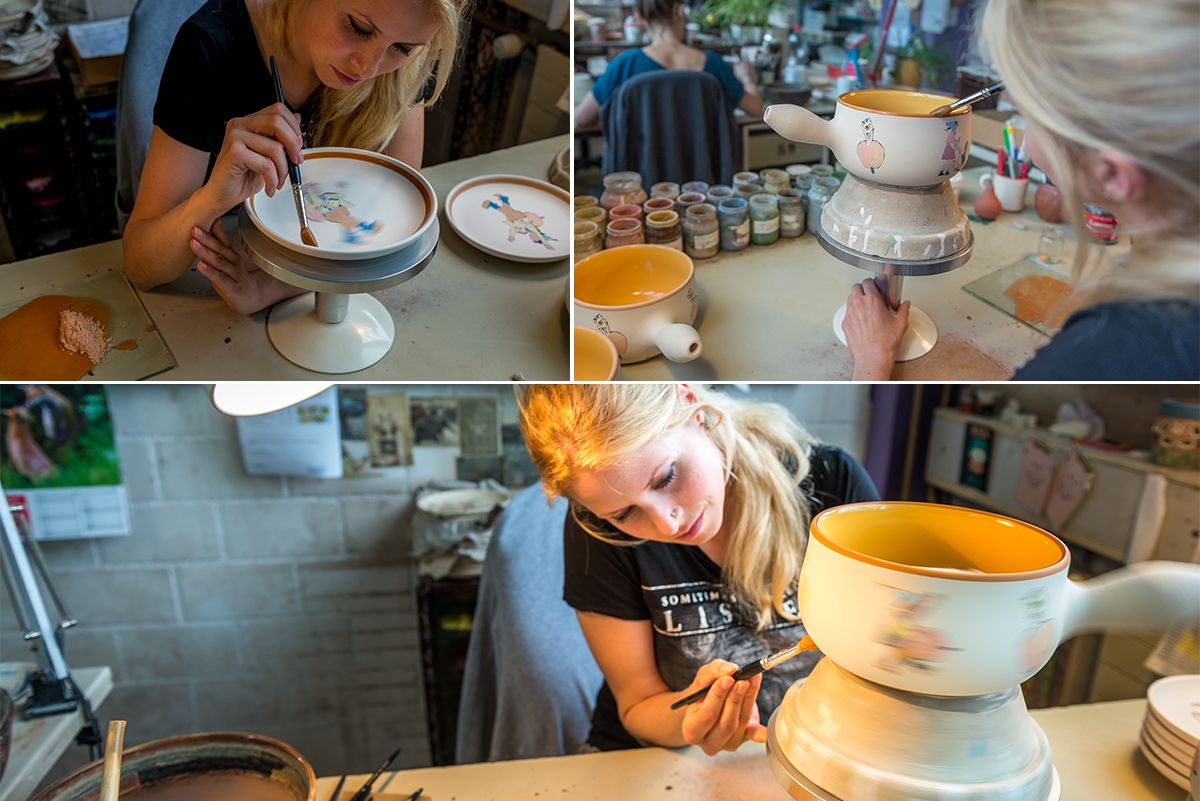

RHEINFELDER CERAMICS
A FONDUE POT IN THE MAKING…
In Rheinfelden, the tranquil little town on the Rhine near Basel – ceramics have been produced for more than 220 years. In the past this meant tiles for ovens and roofs. Today Rheinfelder Keramik (Rh) mainly produces products for lovers of fondue.
What has not changed in all these years is the great need for skilled craftsmanship. Many items are still produced by hand. Rh is one of the last ceramics firms in Switzerland and successfully so.
A glance backstage shows how much manual skill is needed for the individual steps in the process and how much dedication the around 10 employees put into each individual product.
MAKING CAQUELONS AND HANDLES


For good caquelons you need a heat-resistant clay. This comes from Einsiedeln in the canton of Schwyz. For the body of the caquelon the exact quantity of clay required is placed into a mould on the potter’s wheel. The potter shapes the hollow vessel by pressing the bar. In another process the handle is cast from a casting mass of the same clay and removed from the casting mould when as hard as leather.
Then «the marriage» of the still moist caquelons bodies and handles takes place. Clay slip serves as «glue», this is a viscous mixture of water and minerals, which the potter makes out of the same clay, and which ensures an excellent bonding of both parts when fired.
SLIP AND INITIAL FIRING
SLIP AND INITIAL FIRING
In the spraying cabin the base slip is put onto the as yet unfired caquelons by hand. Slip is a runny clay-mineral mass, which is used to colour or coat ceramic products. It is only later, after the first firing, that painted motifs follow and then the glaze.




Now it’s finally time, the first firing takes place and for the first time a computer takes over some of the work. The electronic kiln regulation controls the slow rise in temperature up to 1000°C and ensures a constant temperature during firing for between ten to twelve hours. The cooling down process is also monitored. A rapid drop in temperature would cause cracks and breakages. Good things take time, and so the products are left for up to 30 hours depending on type until the kiln door is opened.
Now it also becomes apparent why the base slip was applied: the base and the inside of the caquelons – places where the slip was not applied have changed colour – just like a lobster in hot water. Grey has turned to red. And this reaction to firing also gives the «red clay» its name. In contrast, the outside glows a bright white. Perfect then for the next steps in the process.


DECALS, YELLOW INNER GLAZE AND SECOND FIRING
Decals are used by the painters of ceramics as a template for the illustrations of “A bell for Ursli”, the book by the same name which first appeared in 1945. These ensure that all illustrations on the fondue products are perfectly reproduced and thus faithful to the originals of the artist Alois Carigiet.
The decals are briefly soaked in water and then carefully applied to the caquelons. So that they adhere well and do not have any creases they are smoothed down with a special adhesive and a rubber spatula.




Then the yellow inner glaze is applied in turn from the spray gun. Here it is important to make sure that the coating is even and sufficiently thick. Too little glaze and there is not enough cover. Too much and it becomes brittle. This is why a feel for the work and a lot of experience are needed.
And then it’s off into the kiln again. This time at 1050°C, but just as long as in the first firing. Here the yellow, jelly-like coating of the decals is burned off. Only the black contours of the Carigiet drawings remain behind.


HAND PAINTED – EVERY PRODUCT A UNIQUE ITEM
Now things get really colourful as the fired ceramics reach the ceramic painting studio.
The painter blends the oxide paints differently for each motif, stacks the ceramic products to be painted up in front of her and starts to colour in the Carigiet templates by hand.
In choosing colours she also adheres very closely to the original. But as every brushstroke, every blade of grass, is done by hand no one product is exactly the same as another.




Each one is a work of art faithful to the artist’s original and yet each one is also a unique item. Depending on the picture concerned, the painter takes 40 to 45 minutes. The application of the filet a coloured ring on the caquelon or the rim of the plate. The right revolution speed of the potter’s wheel plays an important role in a successful outcome here.
Once painting is finished, every painter adds her signature to the hand-painted article. The company’s mark, the «Rh» stamp, together with the reference to the image copyright belonging to Orell Füssli group (which owns the publication rights), means every customer can then recognise that he has an original of high artistic value in front of him.


OUTER GLAZE AND THIRD FIRING
Every item painted is coated with a glaze for hygienic and optical reasons. The transparent glaze is a thin glass coating, which seals the outer surface and helps to protect the ceramic product.
For the third time it’s off into the spraying cabin. The external glaze completely covers the “Bell for Ursli” motifs in white although only until the caquelon is fired for the third and final time in the kiln.




Where possible, no glaze at all is applied to the base of the caquelon. During firing this would “fuse” with the kiln tray and make freeing the caquelons impossible without breaking them. This is why the base of every caquelons is wiped before firing.
When setting up the trolley kiln, every individual caquelon is placed on small metal supports to be absolutely safe. The surface supported is so minimal that “fusing” is barely possible.
After another 24 to 30 hours they are ready, these unique Rheinfelden ceramic caquelons with the wonderful pictures of the “Bell for Ursli” story so well-known throughout Switzerland.





 SWITZERLAND
SWITZERLAND SCHWEIZ
SCHWEIZ SUISSE
SUISSE FRANCE | BELGIQUE
FRANCE | BELGIQUE ESPAÑA
ESPAÑA DEUTSCHLAND | ÖSTERREICH
DEUTSCHLAND | ÖSTERREICH USA
USA UK
UK IRELAND
IRELAND CHINA
CHINA









